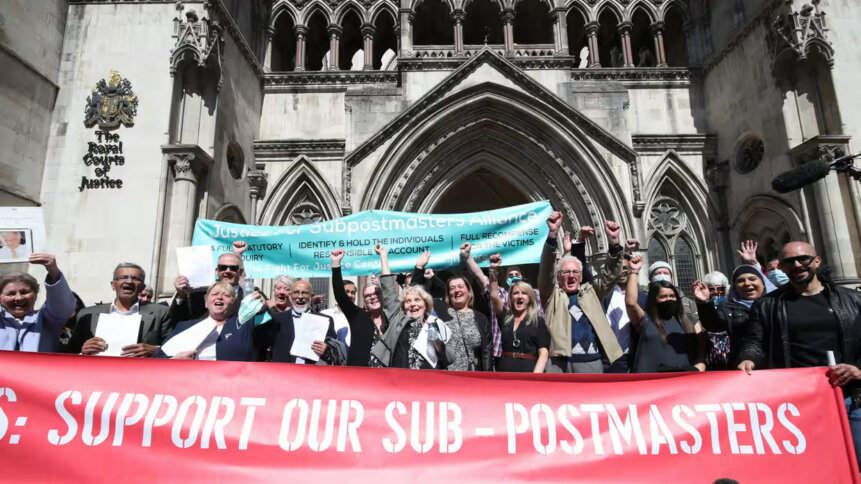How to prosecute an IT system: the Post Office Scandal in short

• The Post office scandal is one of the greatest miscarriages of justice in British history.
• At its heart is a malfunctioning technology – and the refusal to admit it was going wrong.
• People died as a result. Others spent time in prison, and had their families’ lives shattered by the cover-up.
If you haven’t yet watched the UK’s “Post Office Scandal” drama Mr Bates vs. the Post Office, and you have friends in the country, you’ve doubtless been told to. Don’t have time? Can’t get the country’s ITV channel? Want to know more before committing a weeknight to the miniseries? Here’s a rundown of the facts – and the tech – involved in the story.
In what’s becomes known as the greatest miscarriage of justice in UK history, between 1999 and 2015, the UK Post Office pursued operators of sub-post offices across the country. The sub-postmasters were alleged to have committed theft, fraud and false accounting – all based on information from the Post Office’s Horizon IT system.

ITV’s Mr Bates vs. the Post Office has drawn attention back to the Post Office Scandal.
What is Horizon?
In 1999, the Post Office’s single shareholder was the UK government (remember this, it’s important later). That year, accounting processes in around 14,000 Post Office branches were automated, with the introduction of a centralized computer system from Fujitsu.
Horizon, the system that replaced paper-based accounting, was originally developed by UK company ICL, but was acquired by Fujitsu in 1998. The system has an electronic point of sale service (EPOSS) that lets subpostmasters and branch workers key in sales on a touchscreen, with the accounts being automated in the background. At the time of its roll-out between 1999 and 2000, it was the biggest non-military IT project in Europe.
Almost immediately after rollout, there was a sudden increase in the number of sub-postmasters suffering unexplained accounting shortfalls. Rather than connecting the dots – new system, new errors, fix system – the Post Office blamed branch operators for the losses.
Although the technology had changed, the contract between postmasters and the Post Office hadn’t. Postmasters owned their businesses, but were agents for the Post Office. So any accounting shortfalls were the responsibility of the sub-postmasters – unless they could prove otherwise.
The brunt of the responsibility being on postmasters made some sense with paper accounting, when a chain of evidence could be easily traced by individuals. But with the introduction of the new system (that wasn’t an opt-in system), there should have been leeway for mistakes – and someone or something to trace them.
Instead, probably because of the size of the project and the government’s stake in the Post Office, a massive cover-up began.
The first port of call for a sub-postmaster experiencing unexplained losses on the IT system would be the call center helpline. Operators were instructed by the Post Office that anyone calling with Horizon problems should be told they were alone in experiencing this.
Here’s the scope for a scandal: in a normal company, the staff could bring complaints with an external body or would at least have the option to do so. That was not the case at the Post Office.
How it became a Post Office scandal
The Post Office is in a unique position as an employer because it has the power to investigate and prosecute without the need for police intervention. Historically, the Post Office was a public authority – it wasn’t until the Postal Services Act of 2011 that a majority of its shares were floated on the London Stock Exchange.
Then, in 2015 the government sold its remaining shares, ending 499 years of state ownership. If not in 2011, then at this point the structure allowing Royal Mail investigative power should have been examined and, most likely, scrapped.

The first postage stamp – the Penny Black.
Royal Mail lawyers are believed to be the earliest known formal investigators and prosecutors in the modern world, with origins as far back as 1683. With the introduction of the first postage revenue stamp, the Penny Black, postal services were more accessible to the public and volumes of post rose.
Along with that increase came higher crime rates. What had been the Missing Letter Branch of the Post Office was renamed in 1883 to be the Confidential Enquiry Branch, then the Investigation Branch.
Back when letter-writing was the primary means of long-distance communication, it made sense that the experts in letters were the ones with the right to prosecute. The investigations undertaken were serious and varied, including a key role in the detection and capture of the Great Train Robbers.
Since going private in 2015, the Royal Mail Group has retained its investigative branch and legal department, and has prosecuted around 150 cases a year as a private prosecutor.
By 2010, it was known by the Post Office that there were faults in the centralized accounting software. A total of 2500 branch owner-operators were accused of taking money from their businesses and over 700 were prosecuted by the Post Office, despite protesting their innocence and raising the software issues in their defence.
The accused ended up with criminal records and doing community service at the least; several served time in jail. Many were left struggling financially or bankrupt following convictions, and those who didn’t go to court had to financially cover nonexistent shortfalls.
An independent review by Second Sight that was commissioned by the Post Office in 2012 highlighted faults in Horizon which undermined the safety of the convictions that relied on its accuracy and further found the contracts between the Post Office and sub-postmasters to be unfair.
That too was covered up.
Beyond instructing call center operators to let sub-postmasters think they were alone in their experience of issues with Horizon, the head of PR and media for the Post Office helped write a “story” defending Horizon IT system that was then “cut and pasted” as evidence in witness statements used in prosecutions.
Simon Baker, a Post Office employee, asked the company’s media team to help “craft our message,” which had been developed by two lawyers, devising wording that was later used in legal proceedings, the inquiry into the scandal heard.
In 2019, a group of post office operators won a high court case that ruled that their convictions were wrongful, and that the Horizon IT system was at fault. In 2021 it was upheld on appeal (Oh yes – the Post Office appealed!) and paved the way for compensation of workers wrongly accused of committing crimes.
The renewed attention on the case thanks to the dramatization of the Post Office scandal means that politicians are finally getting involved, calling for the names of victims to be cleared and compensation be paid.
Further, the then-CEO of the Post Office, Paula Vennells, left the company “in disgrace” – though that didn’t prevent her receiving a huge payout. Now, UK Prime Minister Rishi Sunak has said there’s consideration to be made about removing her CBE.

A petition calling for Paula Vennells to be stripped of her CBE has gained traction in the UK and the Prime Minister says it could happen.
Two Fujitsu experts who were witnesses in the trials are being investigated for perjury and perverting the course of justice, and there’s talk of Fujitsu having to pay some compensation, too.
READ NEXT

SpaceX: escape to low-Earth orbit
Even after the system was found to be defective, the Post Office has opposed a number of appeals by operators. In fact, no one has really been punished for the scandal, besides its victims. Met Police confirmed on January 5th that the Post Office is under criminal investigation over “potential fraud offences” committed during the scandal.
Despite the Post Office scandal having such widely negative effects, and being linked to at least four suicides, the company has never taken account for its wrongdoings.
In the meantime, the Post Office continues to use the Horizon system. The loss-making Post Office has asked the government for £252m of funding to keep it afloat, including money to cover the cost of updating the controversial IT system, which it still uses with support from developers Fujitsu.

The Post Office scandal left people dead in its wake.
The Post Office scandal was the perfect storm of early digital transformation, lack of regulation and too much internal power. As one of the very first switches from paper to software, more care should have been taken to ensure teething problems were identified and fixed.
Even now, despite standards organizations becoming the norm, the standards they uphold are mostly voluntary. A standards body’s primary function is developing and coordinating the usefulness of technology standards. They create uniformity across producers, consumers and government agencies regarding terminology and protocol.
Had proper oversight been given, the inaccuracies of the Horizon IT system could have been highlighted as issues with the system not its operators.
Now, when searching for regulatory bodies in the tech industry, most focus is given to regulation of the sway that technology companies have – have we really moved beyond a need to ensure the companies employing new technology are doing so fairly?









